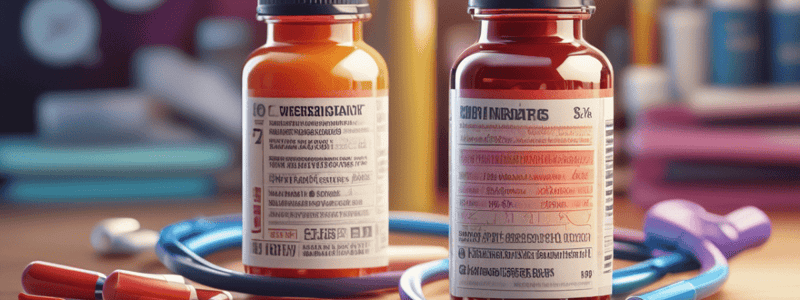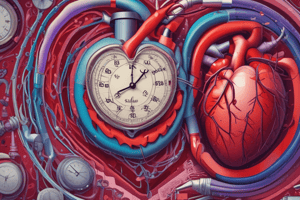Podcast
Questions and Answers
¿Cuál es una ventaja de la terapia de combinación para la hipertensión mencionada en el texto?
¿Cuál es una ventaja de la terapia de combinación para la hipertensión mencionada en el texto?
- Menor adherencia del paciente al tratamiento.
- Menor costo de los medicamentos. (correct)
- Respuesta más lenta al tratamiento.
- Mayor riesgo de efectos secundarios.
¿Cuál es un ejemplo de una terapia inicial efectiva y bien tolerada para la hipertensión, según el texto?
¿Cuál es un ejemplo de una terapia inicial efectiva y bien tolerada para la hipertensión, según el texto?
- Combinación de un diurético y un antagonista del calcio.
- Combinación de un inhibidor de la enzima convertidora de angiotensina (IECA) o un bloqueador del receptor de angiotensina (BRA) con un diurético. (correct)
- Combinación de un beta bloqueador y un diurético.
- Combinación de un vasodilatador y un IECA.
¿Cuál de los siguientes medicamentos NO se menciona como terapia farmacológica de primera línea para la hipertensión en el texto?
¿Cuál de los siguientes medicamentos NO se menciona como terapia farmacológica de primera línea para la hipertensión en el texto?
- Hidroclorotiazida
- Candesartán
- Atenolol (correct)
- Amlodipino
¿Qué demostró el ensayo ACCOMPLISH sobre la terapia de combinación para la hipertensión?
¿Qué demostró el ensayo ACCOMPLISH sobre la terapia de combinación para la hipertensión?
¿Qué tipo de diurético se menciona específicamente como parte de la terapia farmacológica inicial para la hipertensión en el texto?
¿Qué tipo de diurético se menciona específicamente como parte de la terapia farmacológica inicial para la hipertensión en el texto?
¿Cuál es una desventaja potencial de la terapia de combinación para la hipertensión según lo discutido en el texto?
¿Cuál es una desventaja potencial de la terapia de combinación para la hipertensión según lo discutido en el texto?
Flashcards are hidden until you start studying
Study Notes
Hypertension Medication Treatment: Focusing on Combination Therapy, Dosage Administration, and Types of Medicines
Introduction
Hypertension, characterized by persistently elevated blood pressure, is a prevalent condition affecting millions of adults worldwide. Prolonged hypertension increases the risk of developing cardiovascular diseases (CVD). Treatment strategies involve a combination of lifestyle modifications and medications.
Combination Therapy
When blood pressure (BP) exceeds the target by more than 20/10 mmHg, combination therapy is considered beneficial due to advantages such as improved patient compliance, fewer side effects, faster response, and potentially lower costs. The combination of an angiotensin-converting enzyme (ACE) inhibitor or angiotensin receptor blocker (ARB) with a diuretic is an effective and well-tolerated initial regimen. Additionally, the ACCOMPLISH trial demonstrated that the combination of a calcium channel blocker plus an ACE inhibitor is also very effective. Although some combinations may have increased risk of side effects, they are still considered valuable therapeutic options.
Types of Medicines and Doses
First-line drug therapy for hypertension includes thiazide or thiazidelike diuretics such as hydrochlorothiazide or chlorthalidone, angiotensin-converting enzyme inhibitors or angiotensin receptor blockers such as enalapril or candesartan, and calcium channel blockers like amlodipine. These medications should be titrated according to office and home systolic blood pressure (SBP)/diastolic blood pressure (DBP) levels to achieve targets of <130/80 mm Hg for adults under 65 years and <130 mm Hg in those aged 65 years and above. The choice and dosage of medication depend on individual patient needs and medical history.
Thiazide Diuretics
Thiazide diuretics are effective first-line agents in hypertension management. They work by increasing sodium excretion, leading to reduced blood volume and decreased cardiac output. Commonly used thiazides include hydrochlorothiazide or chlorthalidone.
Calcium Channel Blockers (CCBs)
CCBs are strong antihypertensive drugs that can lower both SBP and DBP through vasodilation mechanisms. Examples include amlodipine.
Angiotensin-Converting Enzyme (ACE) Inhibitors and Angiotensin Receptor Blockers (ARBs)
ACE inhibitors and ARBs are another class of medications used in hypertension treatment. They work by blocking the renin-angiotensin system, thereby reducing blood pressure. Examples include enalapril or candesartan.
Other Medications
Alpha-blockers like doxazosin may be prescribed for specific cases, such as hypertensive men with benign prostate hypertrophy. Direct vasodilators like hydralazine and minoxidil can also be used but are typically reserved for severe hypertension or renal insufficiency due to their side effects.
Conclusion
The pharmacological treatment of hypertension involves a combination of lifestyle modifications and medication use. Combination therapy is beneficial when BP exceeds target levels by more than 20/10 mm Hg. The choice of medication depends on individual patient needs and medical history, and medications should be titrated according to office and home SBP/DBP levels to achieve the recommended targets.
Studying That Suits You
Use AI to generate personalized quizzes and flashcards to suit your learning preferences.




